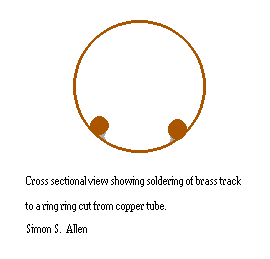Rolling Ball Technology
An Online Technical Reference Devoted to
Rolling Ball Sculptures, Clocks, and other Devices
By Members of the rolling-ball@lemur.com List
Material by Simon S. Allen and Nicholas Carter
Edited by David M. MacMillan

Simon S. Allen suggests the following method of track construction.
I propose that the two lengths of brass rod are used for the track. They are held an equal distance apart. The problem is to devise a method of holding the brass rods apart without impeding the passage of the ball. I suggest that a piece of copper tube is used. Dimensions of 1/8 inch brass rod, 1/2 inch balls with 7/8 inch copper tube work well together. It is very easy to solder brass to copper. Once all the materials have been cleaned (and polished if you wish), cut from the 3/4 inch tube a piece 1/4 to 3/8 inch long. Using some wet and dry on a glass plate clean the end of the piece to give smooth edges. The inside to the copper tube must also be clean as this will be where the solder goes. Next slide the ring over the two pieces of brass rod. You will need a jig to hold the rod the required distance apart. Apply a little solder underneath. You now have the track firmly held. Repeat the process for other links.
The addition of the copper tube also makes it easy to support the tracking by securing the copper tubes to fabricated supports.
Metal rings of uniform size and reasonably accurate roundness have many applications in rolling ball work. Nicholas Carter presents the following method:
If you make a coil of the brass wire by bending a length of it around and around a mandrel , you can then cut 1/2 circles from it quite easily. You can even make the mandrel oval or square depending on the profile of "U" you desire. Cut lengthwise to make rings, then cut each ring in half.
Nicholas Carter is a jeweler, lapidary, and metalworker in Oregon. His work may be seen every Saturday at the Saturday Market in downtown Eugene, Oregon. His web page is at http://www.pioneer.net/~felice/
With the exception of material noted as being in the public domain, the text, images, and encoding of this document are copyright © 1997 and 1998 by their author(s) and editor(s): Simon S. Allen, Nicholas Carter, and David M. MacMillan.
This document is licensed for private, noncommercial, nonprofit viewing by individuals on the World Wide Web. Any other use or copying, including but not limited to republication in printed or electronic media, modification or the creation of derivative works, and any use for profit, is prohibited.
This writing is distributed in the hope that it will be useful, but "as-is," without any warranty of any kind, expressed or implied; without even the implied warranty of merchantability or fitness for a particular purpose.
In no event will the author(s) or editor(s) of this document be liable to you or to any other party for damages, including any general, special, incidental or consequential damages arising out of your use of or inability to use this document or the information contained in it, even if you have been advised of the possibility of such damages.
In no event will the author(s) or editor(s) of this document be liable to you or to any other party for any injury, death, disfigurement, or other personal damage arising out of your use of or inability to use this document or the information contained in it, even if you have been advised of the possibility of such injury, death, disfigurement, or other personal damage.
All trademarks or registered trademarks used in this document are the properties of their respective owners and (with the possible exception of any marks owned by the author(s) or editor(s) of this document) are used here for purposes of identification only. A trademark catalog page lists the marks known to be used on these web pages. Please e-mail dmm@lemur.com if you believe that the recognition of a trademark has been overlooked.
Version
2.2, 1998/06/20.
Feedback to dmm@lemur.com
http://www.database.com/~lemur/rbt-construction.html
Go to the: